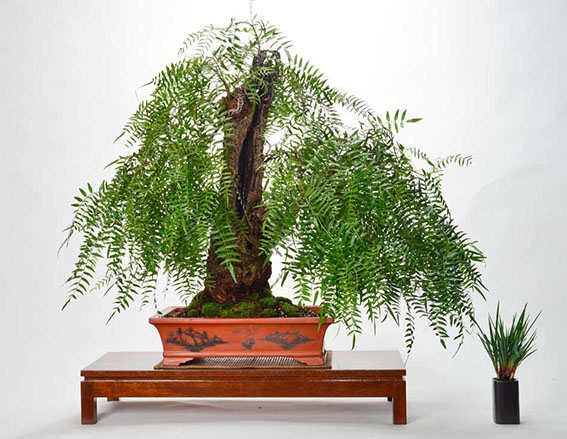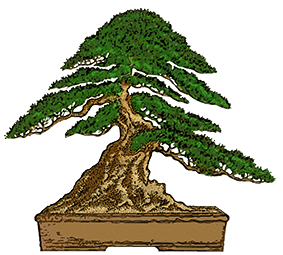Peppercorns as bonsai

The peppercorn (schinus molle) is a native of Peru and prefers rich, well-drained moist soils in an open, sunny position. An evergreen tree, it is drought resistant but frost tender. The stem is erect and twisted, with rough, blackish bark.
In the Mediterranean climate of South Australia, peppercorns flourish and well established ones have stunning gnarled, lumpy trunks. Their foliage of course is weeping and graceful. They grow easily from seed which must ripe and red for success. For us they grow rapidly and they shoot on old wood.
It is possible to find seedlings under an established tree, but I have never heard of anybody being able to grow from a cutting.
I have learnt that they are water lovers. In our hot summer, they can be kept in a water bath, but make sure that the water doesn’t heat up and they are not expected to ‘live’ in water.
I advise growing seedlings in a large box or in the ground for one or two years, to thicken up the trunk. They transplant well although its best to avoid doing this in the middle of summer. Sacrifice branches help thicken the trunk but be careful that the sacrifice branch does not become too strong and dominant which can be counterproductive, robbing the main trunk of vigour to the point that it dies off.
It is important to create the weeping effect as soon as the main trunk has been established. I keep pieces of wire on the bench next to my peppercorns so that as soon as I see a strong shoot appear, I loosely wire it to the weeping style. Be careful not to wire in a boing manner, even if your wiring is loose. The weeping branches should fall gracefully but with plenty of movement both from side to side, towards the trunk and out to the edge of the outline of the tree.
If you study old peppercorn trees, you may notice that the trunks can become quite lumpy and they do not have good taper, but quite often actually have reverse taper. When the trunks are reasonably formed, at least 1.5 to 2 cm in diameter, I apply a couple of cable ties around the base of the trunk very tightly at least 2.5 cm apart and leave these ties on the trunk until the trunk thickens to such a point that it breaks the cable ties. I then apply another couple of cable ties around another part of the trunk and wait for the tree to break them also. In this manner the tree grows a lump around the cable tie both above and below it, forcing the tree to thicken in an irregular manner and become very interesting.
I keep my peppercorns in full sun. They are watered as much as the figs or any other water-loving plants. They can suffer die back, but I think this is probably a sign that they need repotting.
If peppercorns grow in your area, I can recommend that you have a go at creating one as a bonsai.

